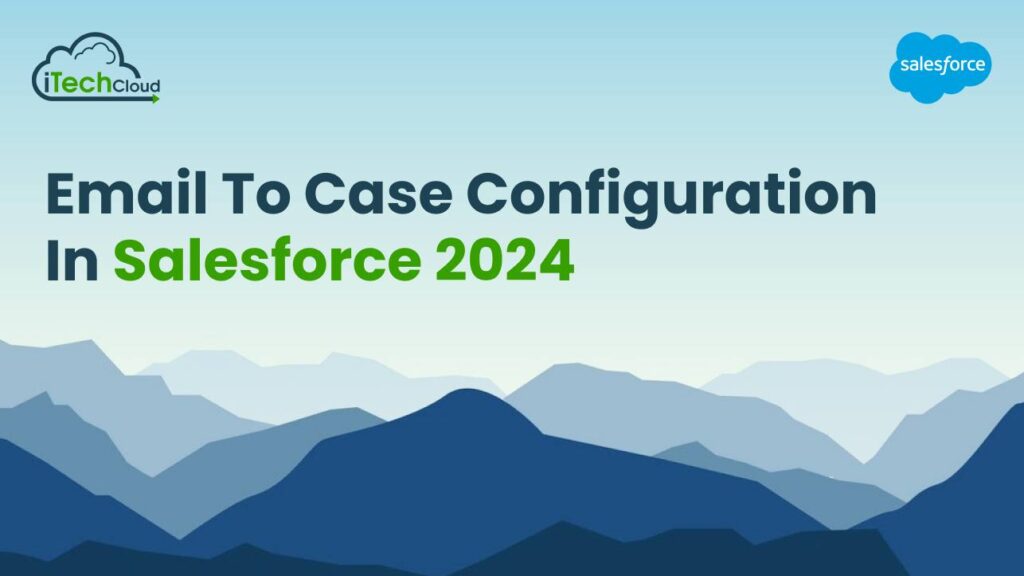Email to Case Configuration in Salesforce 2024

The dynamic world of customer service management, efficiency and effectiveness are paramount. As businesses strive to streamline their operations and enhance customer satisfaction, leveraging the right tools becomes crucial. Among these tools, Salesforce stands out as a versatile platform offering a multitude of features, including Email to Case Configuration, which continues to evolve in its 2024 iteration.
Table of Contents
Understanding Email to Case Configuration in Salesforce:
Email to Case Configuration is a functionality within Salesforce that automatically converts incoming emails from customers into cases, thereby facilitating seamless case management. It eliminates the need for manual intervention, ensuring that customer queries are promptly addressed and tracked within the Salesforce ecosystem.
Evolution of Email to Case in Salesforce 2024:
Salesforce refines and enhances its features to better align with user needs and technological advancements. In 2024, Email to Case has undergone significant improvements, focusing on:
1. Automation Enhancements
Automation lies at the heart of efficient case management. In Salesforce 2024, Email to Case Configuration introduces advanced automation capabilities, allowing users to configure complex workflows and rules governing the handling of incoming emails. Whether it’s assigning cases to the right agents, setting priority levels, or triggering follow-up actions, the enhanced automation empowers organizations to streamline their processes and deliver faster resolutions.
2. Integration with AI and Machine Learning
The integration of AI and machine learning technologies elevates Email to Case Configuration to new heights of intelligence and efficiency. By analyzing email content, sentiment, and historical data, Salesforce can intelligently route cases, suggest relevant knowledge base articles, and even predict potential resolutions. This not only accelerates case resolution times but also enhances the overall customer experience by providing personalized and proactive support.
3. Omni-channel Support
Customers expect seamless support across various communication channels. Salesforce 2024 extends Email to Case Configuration beyond traditional email channels to encompass social media, chat, and messaging platforms. This omnichannel approach ensures that all customer inquiries, regardless of their origin, are captured, centralized, and processed within the Salesforce environment, fostering consistency and coherence in customer interactions.
4. Enhanced Analytics and Reporting
Data-driven insights are invaluable for optimizing service performance and identifying areas for improvement. Salesforce 2024 enhances its analytics and reporting capabilities within Email to Case, providing users with comprehensive dashboards and metrics to track key performance indicators (KPIs), such as response times, resolution rates, and customer satisfaction scores. Armed with these insights, organizations can make informed decisions, refine their strategies, and drive continuous improvement in their customer service operations.
5. Mobile Optimization
In an increasingly mobile-centric world, flexibility and accessibility are essential. Salesforce 2024 optimizes Email to Case for mobile devices, empowering agents to manage cases on the go. Whether they’re in the field, traveling, or working remotely, agents can stay connected, respond to customer inquiries, and collaborate with colleagues seamlessly from their smartphones or tablets. This mobility not only enhances productivity but also enables organizations to deliver timely and responsive support regardless of location.
Best Practices for Email to Case Configuration:
The capabilities of Email to Case, configuring it effectively is key to maximizing its benefits. Here are some best practices to consider:
1. Define Clear Case Assignment Rules
Establishing robust case assignment rules ensures that incoming emails are routed to the most appropriate agents or teams based on predefined criteria such as product type, customer segment, or geographical region. By automating this process, organizations can expedite case resolution and minimize the risk of misallocation or oversight.
2. Leverage Email Templates and Macros
Email to Case Configuration templates and macros are invaluable tools for standardizing responses, reducing agent workload, and ensuring consistency in communication. By creating predefined templates for common inquiries and leveraging macros for repetitive tasks, organizations can streamline their response process, improve efficiency, and maintain a cohesive brand voice across all interactions.
3. Implement Service Level Agreements (SLAs)
Service Level Agreements (SLAs) define the expected response and resolution times for different types of cases, helping organizations prioritize and manage their workload effectively. By configuring SLAs within Salesforce, organizations can set clear expectations for both agents and customers, monitor performance against predefined targets, and take proactive measures to address any deviations or bottlenecks.
4. Integrate with Knowledge Base and Community Portals
Integrating Email to Case Configuration with knowledge base articles and community portals empowers agents to access relevant information and resources quickly, enabling them to provide accurate and timely responses to customer inquiries. By leveraging self-service options and deflecting repetitive queries, organizations can reduce case volumes, improve efficiency, and enhance the overall customer experience.
5. Continuously Monitor and Optimize Performance
Continuous monitoring and optimization are essential for ensuring the ongoing success of Email to Case Configuration. By regularly reviewing metrics, analyzing trends, and soliciting feedback from agents and customers, organizations can identify areas for improvement, refine their processes, and adapt to changing customer needs and preferences.
Conclusion:
Email to Case remains a cornerstone feature within Salesforce, enabling organizations to streamline their operations, enhance efficiency, and deliver exceptional customer experiences. With the advancements introduced in Salesforce 2024, including enhanced automation, AI integration, omnichannel support, and mobile optimization, Email to Case continues to evolve to meet the evolving needs of modern businesses. By adopting best practices and leveraging the full potential of Email to Case, organizations can unlock new levels of productivity, responsiveness, and customer satisfaction in 2024 and beyond.

